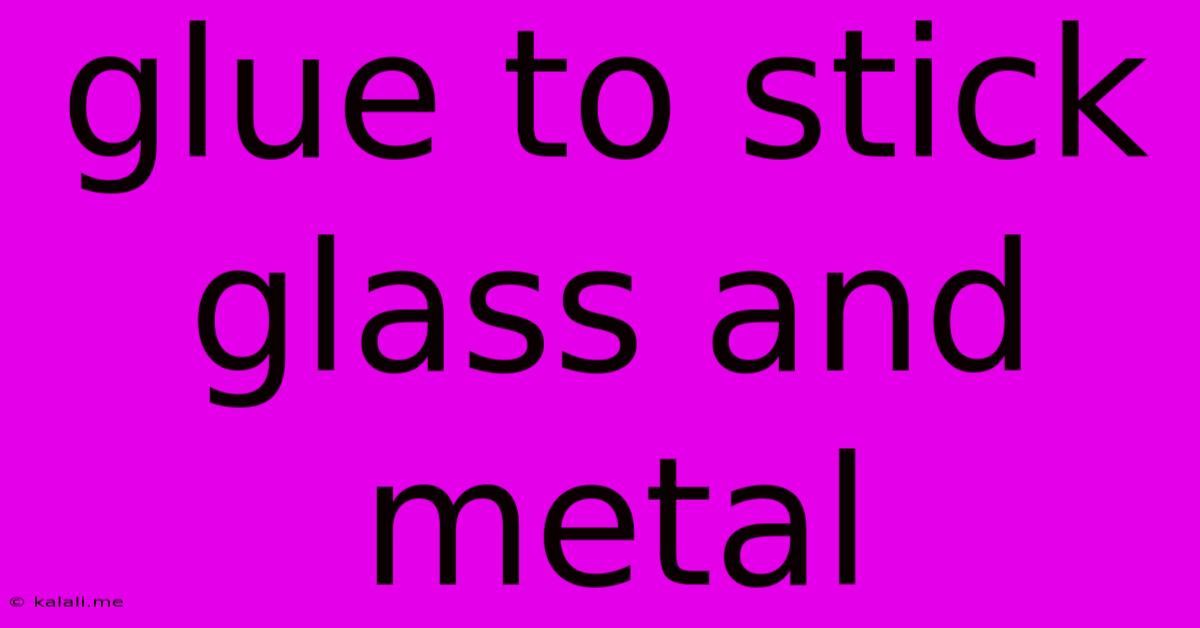Glue To Stick Glass And Metal
Kalali
May 22, 2025 · 3 min read

Table of Contents
The Best Glue for Sticking Glass and Metal: A Comprehensive Guide
Choosing the right adhesive for bonding glass and metal can be tricky. This guide explores various glues, their strengths and weaknesses, and helps you select the perfect one for your project, whether it's a delicate repair or a robust industrial application. This will cover crucial factors like surface preparation, application techniques, and curing times to ensure a strong, long-lasting bond.
Understanding the Challenges of Glass and Metal Bonding
Glass and metal present unique challenges when it comes to adhesion. Glass is smooth, non-porous, and brittle, while metals can be prone to oxidation. Finding an adhesive that can effectively bridge this gap and create a strong, durable bond requires careful consideration. The type of metal also matters; ferrous metals (like steel and iron) react differently to adhesives than non-ferrous metals (like aluminum and copper).
Types of Glue Suitable for Glass and Metal
Several adhesive types are suitable for bonding glass and metal, each with its own advantages and disadvantages:
1. Epoxy Resin: This is arguably the most popular choice for its exceptional strength, versatility, and durability. Epoxy resins create a strong chemical bond with both glass and most metals. They are available in various formulations, including gap-filling varieties ideal for uneven surfaces. Key advantages: High strength, excellent adhesion, gap-filling capabilities, chemical resistance. Key disadvantages: Longer curing times, can be messy to work with, may require specific surface preparation.
2. Cyanoacrylate (Super Glue): Super glue offers incredibly fast bonding, making it convenient for quick repairs. However, it's crucial to choose a formula specifically designed for glass and metal. Key advantages: Extremely fast curing time, strong initial bond. Key disadvantages: Can be brittle, susceptible to cracking under stress, less durable than epoxy in the long run, smaller gap-filling capacity.
3. UV Cure Adhesives: These adhesives cure when exposed to ultraviolet (UV) light, offering precise control over the curing process. They are often used in situations where speed and precision are critical. Key advantages: Fast curing with UV light, high precision application, strong bond. Key disadvantages: Requires a UV light source, can be more expensive than other options.
4. Silicone Sealants: While not as strong as epoxies, silicone sealants provide excellent flexibility and water resistance, making them suitable for applications where movement or exposure to moisture is a concern. Key advantages: Flexible, waterproof, good for sealing gaps. Key disadvantages: Lower strength compared to epoxies, not ideal for high-stress applications.
Choosing the Right Glue: Factors to Consider
The best glue for your project depends on several factors:
- Strength Required: For high-stress applications, epoxy is the preferred choice. For lighter-duty projects, super glue or silicone sealant may suffice.
- Curing Time: If you need a quick fix, super glue or UV cure adhesives are ideal. Epoxy requires more patience.
- Gap Size: Epoxy is best for filling gaps, while super glue is better suited for tight fits.
- Environmental Conditions: Consider moisture, temperature, and chemical exposure when selecting an adhesive.
Application Tips for Optimal Bonding
Regardless of the glue type, proper surface preparation is vital for a strong bond. Clean both the glass and metal surfaces thoroughly using a suitable degreaser and allow them to dry completely. For best results, use a primer specifically designed for glass and metal bonding, especially with epoxy. Follow the manufacturer's instructions meticulously for application and curing times.
Conclusion
Selecting the appropriate glue for bonding glass and metal involves understanding the properties of each material and the specific requirements of your project. By carefully considering the factors outlined above and following the application instructions, you can achieve a strong and durable bond that will last. Remember, proper preparation and the right adhesive are key to a successful outcome.
Latest Posts
Latest Posts
-
How To Get Tarmac Out Of Clothes
May 22, 2025
-
Does An Induction Hob Get Hot
May 22, 2025
-
Is Apple Id Same As Icloud Id
May 22, 2025
-
King James Vs New King James Bible
May 22, 2025
-
Check Ipad Type By Serial Number
May 22, 2025
Related Post
Thank you for visiting our website which covers about Glue To Stick Glass And Metal . We hope the information provided has been useful to you. Feel free to contact us if you have any questions or need further assistance. See you next time and don't miss to bookmark.